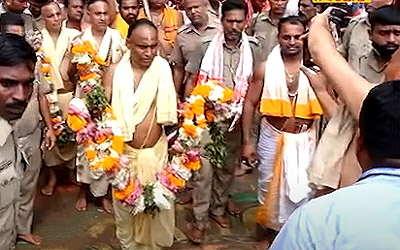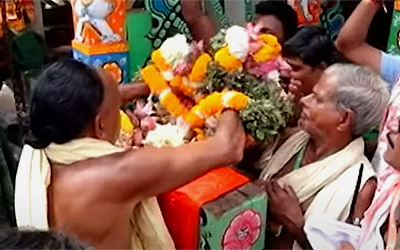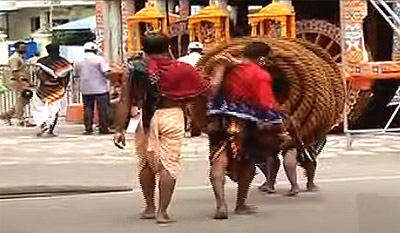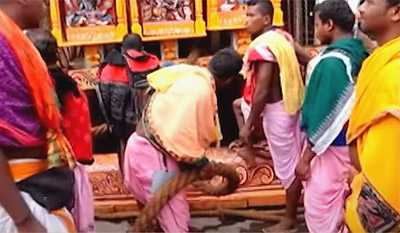DAKSHINA MODA OF CHARIOTS
After reaching Gundicha temple, the three chariots parked facing the western gate of the temple. The Deities enter Gundicha temple through this western gate, but they leave the temple via the eastern gate, known as the Nakachana Dwara. The next day of Hera Panchami is an important day of the Car Festival. On this day the Dakshina Moda ritual (turning the chariots facing the south) is celebrated to bring the chariots from the western gate to the eastern gate and prepare them for the return car festival (Bahuda Yatra).
As per tradition, after 'Sakala Dhupa' ritual in Gundicha temple, the Angyamala (divine garland) from the three deities are brought and are given to the three Palia Puja Panda servitors of each chariot. They proceed to the chariots in a procession with sounds of bells, cymbals, kahali and chhatri, and offer the Angyamala. After the Angyamala bije, Bhoi servitors will attach the breaks and the ropes of the chariots. After sound of the Bije Kahali, the security forces start the Dakhina Moda of the chariots. The order followed during Dakshina Moda is, the chariot of Subhadra (Devadalana) will move first, then the chariot of Balabhadra (Taladhwaja) and at last the chariot of Jagannath (Nandighosa). General public is allowed to pull the chariots during Dakshina Moda, but mostly police and other security personnel pulled the chariots.




All the chariots are pulled half a mile from the western gate before they can be positioned in the way required at the eastern gate. The chariot of Subhadra (Devadalana) is positioned in the middle (in the middle), the chariot of Balabhadra (Taladhwaja) is positioned in the west (in the left) and the chariot of Jagannath (Nandighosa) is positioned in the east (in the right). After Dakshina Moda, the chariots are positioned in front of the Nakachana dwara (eastern gate) and face south towards Lord Jagannath temple. Special dry snacks are offered at the end of the Dakshina Moda ritual, and this is known as 'Ratha Bhoga'. At the end, the chariots are thoroughly checked by Maharana (carpenter), Darji (Tailor) and Bhoi servitors. If required necessary repair work of the chariots is taken up.

RASA LILA AT GUNDICHA TEMPLE
Dakshina Moda ritual also marks the commencement of the three-day 'Rasa Lila' of Lord Jagannath at Shree Gundicha temple. Rasa Lila is described in Hindu scriptures (Bhagavata Purana and Gita Govinda) as a night in Vrindavan when Lord Krishna danced with his consort Radha and other Gopis. The image of Lord Jagannath is taken to the Rasa mandapa (a temple hall) of the Gundicha temple where poems and songs from the Gita Govinda are sung for the last three days of his stay in the temple. During the Rasa Lila, the interaction between Jagannath/Krishna and the Gopis is enacted through the Gita Govinda verses. In the times past, Devadasis sang the verses, but now they are sung by the temple servitors. This is the reason why Vaishnavas consider the Gundicha temple as Vrindavan during Lord Jagannath's sojourn here.
The Car Festival conveys the climax of Manaviya-Lila (human-like activities), which God is performing. Lord Jagannath represents Lord Vishnu who is also Lord Krishna. The Jagannath temple is regarded to be a representation of 'Dwaraka' and the Gundicha temple represents 'Vrindavan'. Lord Jagannath's visit to His Janma Vedi (birthplace) represents his returning back to His childhood days spent as Krishna in Vrindavan. Here, He engages in those pastime activities. The seven days stay of Lord Jagannath and His siblings at the Gundicha temple is an escape from the year-long stay at Jagannath temple to the bliss of Gupta Vrindavan (Gundicha Temple).
Sandhya Darshan at Gundicha Temple
The day before the Bahuda Ratha Yatra (Return Car Festival), is a most auspicious day for devotees in Gundicha temple. This day is known as Sandhya Darshan (Evening Darshan) or Navami Darshan. Some say it as Adapa Mandapa Darshan. It is narrated in Skanda Purana that those who get the opportunity to see the Deities at evening time on this day, the auspiciousness and virtuous are ten times more than the day time. As per tradition, on this day thousands of devotees visit the temple to have darshan of Deities on Adapa Mandapa and partake of Adapa Abhada. After spending seven days in the Gundicha temple, the return journey of Jagannath, Balabhadra, Subhadra and Chakraraj Sudarshan starts on the next day which is known as Bahuda Yatra (Return Car Festival).
It is also described in Niladri Mahodaya that seeing the Deities continuously for ten years in Nilachala (Jagannath temple) is equivalent to witness the Deities for one day only at Adapa Mandapa at Gundicha Temple. Especially, if one sees the Deities during evening hours gets ten times more than the desired results. The timing of Sandhya Darshana is shown in the time-table published by the Temple Administration. After the completion of 'Badasinghara' ritual, on the said day, Palia servitors cover the face of the Deities with Gita Govinda Khandua saree and leave Gundicha Temple. The Kotha Suansia servitors fix a charamala (a flight of stairs made up of logs of coconut tree) on the Simhasana and the Daitapati servitors perform 'Bahutakanti' and other secret rituals.
| Content Navigation | ||
| Last Page | ||
|
||
| Next Page | ||
|

